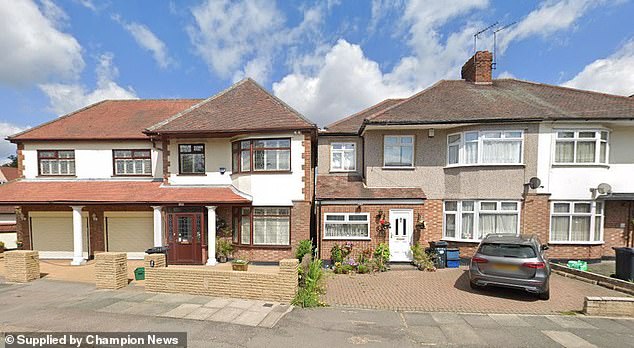A pensioner has lost a ‘ridiculous’ £280,000 legal battle against her neighbour over just a few inches of land.
Christel Naish, 81, and her doctor neighbour Jyotibala Patel had been fighting over an inches-wide strip between their houses – which was too narrow for a person to comfortably walk down.
Ms Naish complained that Dr Patel’s garden tap and pipe were ‘trespassing’ on her property in Ilford, east London and after several rounds of litigation, brought her case before the High Court.
Senior Judge Sir Anthony Mann said in the High Court that the offending strip of land was ‘not worth arguing about’ and criticised Ms Naish for ‘bringing litigation in to disrepute’.
The decision marks the end of a seven-year legal battle started by Ms Naish after she returned to the property in 2001 following her father’s death.
It comes after a trial at Mayors and City County Court in central London, which last year ruled in Dr Patel’s favour on the boundary issue – landing Ms Naish with more than £200,000 in lawyers’ bills.
Following the trial, the pensioner had been told to pay for 65 per cent of her neighbours’ costs – amounting to about £100,000 – on top of the six-figure sum she ran up herself.
The appeal is costing more than £30,000, the High Court heard, and Ms Naish’s lawyers say there could be ‘another £200,000’ spent on a second trial if she succeeds.

Christel Naish, 81, had complained that her neighbour Dr Jyotibala Patel’s garden tap and pipe were ‘trespassing’ on her property in Ilford, east London (pictured)

Ms Naish (pictured) and her doctor neighbour had been fighting over an inches-wide strip between their houses too narrow for a person to comfortably walk down
At the High Court, Sir Anthony criticised the parties for the ‘ridiculous’ row after hearing the tap and pipe issue which began the dispute did not even matter anymore – with the tap having now been removed by Dr Patel.
He told Ms Naish’s lawyers: ‘Hundreds of thousands of pounds about a tap and a pipe that doesn’t matter – this brings litigation into disrepute.
‘You don’t care about the pipe and the tap, so why does it matter, for goodness’ sake, where the boundary lies? It seems to me to be a ridiculous piece of litigation – on both sides, no doubt.’
The court heard Ms Naish first moved into her semi-detached house as a teenager with her parents and, although she moved out, frequently returned as she worked from there in the family’s tarmac business.
She eventually moved back permanently after the death of her father in 2001, with Dr Patel and husband Vasos Vassili buying the house next door for £450,000 in 2013.
The couple’s barrister Paul Wilmshurst told the judge the dispute began due to Ms Naish complaining a tap and pipe outside their house trespassed on her land.
He accused her of ‘terrorising’ the couple with ‘petty and vindictive’ complaints and that they felt forced to sue due to the ‘blight’ on their home’s value caused by the unresolved row.
At the county court, they said they owned the tiny gap between the houses created when previous occupants built an extension on a much wider gap in 1983.

Following the trial, the pensioner had been told to pay for 65 per cent of her neighbours’ costs – amounting to about £100,000 (Ms Patel pictured left outside the High Court, London)
They insisted the boundary between the two properties was the flank wall of Ms Naish’s house and not the edge of her guttering hanging above, as she claimed.
After hearing the trial in 2023, Judge Stephen Hellman last year found for Dr Patel and Mr Vassili, ruling that Ms Naish’s flank wall was the boundary and the couple owned the gap between the houses.
However, he found against them on Ms Naish’s counter-claim, under which she sought damages for damp ingress into her conservatory caused by the couple having installed decking above the level of her damp-proof course.
The judge found that, although the damp problem was already in existence, the installation of the decking screed was a 20 per cent contribution to it and he awarded Ms Naish £1,226 in damages.
But because he had found against her on who owns the gap between the houses, he ordered she pay 65 per cent of her neighbours’ lawyers’ bills.
Concluding his judgment, he said: ‘Now that the parties have the benefit of a judgment on the various issues that have been troubling them, I hope that tensions will subside and that they will be able to live together as good neighbours.’
Ms Naish has continued to fight and took her case to the High Court for an appeal last week, with judge Sir Anthony asking why the neighbours were pressing on and demanding of Ms Naish’s barrister David Mayall: ‘What is the point of this litigation?’
Mr Mayall replied: ‘To be frank, two things – costs and the damp issue.’
Dr Patel’s barrister Mr Wilmshurst said the couple felt they had to fight to protect the value of their home.
He added: ‘It’s because for many years the appellant has been making allegations about the trespassing nature of the [tap and pipe], thereby making it impossible for them to sell their house.’
For Ms Naish, Mr Mayall argued that Judge Hellman’s reasoning in finding that the boundary was the flank wall was ‘fatally flawed’ and should be overturned – although he noted a second trial in the event of a successful appeal would cost the parties ‘another £200,000’.
Mr Mayall said any ‘reasonable purchaser’ looking at the houses when they were first built and conveyed in the 1950s would have assumed that the boundary was the edge of Ms Naish’s guttering, giving her a few inches of extra land.
He added: ‘The only proper conclusion that he could have come to when construing the original conveyance was that the boundary ran along the outermost part of the house as constructed, including the eaves, guttering and foundations.’
For Dr Patel, who appeared in court, and Mr Vassili, who watched via a video link, Mr Wilmshurst said the appeal was a challenge to findings the judge was entitled to make on the evidence.
He said: ‘Overall, the judge did not overlook the contention of the appellant as to guttering, eaves and foundations – he considered it directly, evaluated it, and rejected it as being material to where the boundary was.
‘The judge correctly held that the legal boundary was shown by the conveyance plans as running along the flank wall of [Ms Naish’s house], not the outermost projection.’
On the issue of what contribution to Ms Naish’s damp her neighbours’ decking screed caused, he added: ‘There is no basis on which it can be properly said that the judge was wrong to find the concrete screed was only responsible for 20 per cent of the damp problems.
‘The judge also carried out a site view and was in the best position to form an assessment of the evidence.’
After a day in court, Sir Anthony reserved judgement on the appeal.











